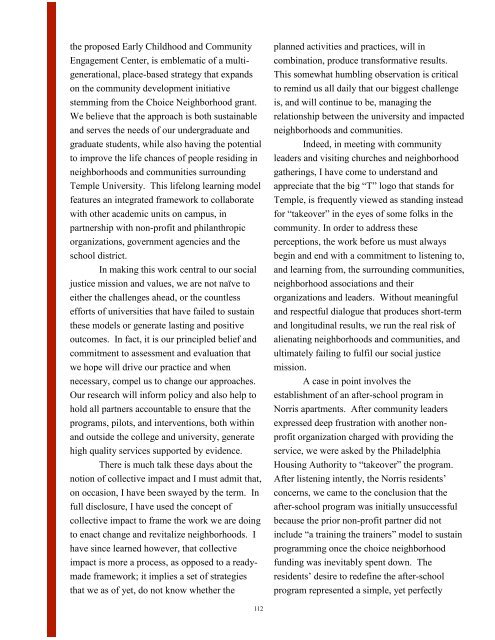CLC-Conference-Proceeding-2018
You also want an ePaper? Increase the reach of your titles
YUMPU automatically turns print PDFs into web optimized ePapers that Google loves.
the proposed Early Childhood and Community<br />
Engagement Center, is emblematic of a multigenerational,<br />
place-based strategy that expands<br />
on the community development initiative<br />
stemming from the Choice Neighborhood grant.<br />
We believe that the approach is both sustainable<br />
and serves the needs of our undergraduate and<br />
graduate students, while also having the potential<br />
to improve the life chances of people residing in<br />
neighborhoods and communities surrounding<br />
Temple University. This lifelong learning model<br />
features an integrated framework to collaborate<br />
with other academic units on campus, in<br />
partnership with non-profit and philanthropic<br />
organizations, government agencies and the<br />
school district.<br />
In making this work central to our social<br />
justice mission and values, we are not naïve to<br />
either the challenges ahead, or the countless<br />
efforts of universities that have failed to sustain<br />
these models or generate lasting and positive<br />
outcomes. In fact, it is our principled belief and<br />
commitment to assessment and evaluation that<br />
we hope will drive our practice and when<br />
necessary, compel us to change our approaches.<br />
Our research will inform policy and also help to<br />
hold all partners accountable to ensure that the<br />
programs, pilots, and interventions, both within<br />
and outside the college and university, generate<br />
high quality services supported by evidence.<br />
There is much talk these days about the<br />
notion of collective impact and I must admit that,<br />
on occasion, I have been swayed by the term. In<br />
full disclosure, I have used the concept of<br />
collective impact to frame the work we are doing<br />
to enact change and revitalize neighborhoods. I<br />
have since learned however, that collective<br />
impact is more a process, as opposed to a readymade<br />
framework; it implies a set of strategies<br />
that we as of yet, do not know whether the<br />
planned activities and practices, will in<br />
combination, produce transformative results.<br />
This somewhat humbling observation is critical<br />
to remind us all daily that our biggest challenge<br />
is, and will continue to be, managing the<br />
relationship between the university and impacted<br />
neighborhoods and communities.<br />
Indeed, in meeting with community<br />
leaders and visiting churches and neighborhood<br />
gatherings, I have come to understand and<br />
appreciate that the big “T” logo that stands for<br />
Temple, is frequently viewed as standing instead<br />
for “takeover” in the eyes of some folks in the<br />
community. In order to address these<br />
perceptions, the work before us must always<br />
begin and end with a commitment to listening to,<br />
and learning from, the surrounding communities,<br />
neighborhood associations and their<br />
organizations and leaders. Without meaningful<br />
and respectful dialogue that produces short-term<br />
and longitudinal results, we run the real risk of<br />
alienating neighborhoods and communities, and<br />
ultimately failing to fulfil our social justice<br />
mission.<br />
A case in point involves the<br />
establishment of an after-school program in<br />
Norris apartments. After community leaders<br />
expressed deep frustration with another nonprofit<br />
organization charged with providing the<br />
service, we were asked by the Philadelphia<br />
Housing Authority to “takeover” the program.<br />
After listening intently, the Norris residents’<br />
concerns, we came to the conclusion that the<br />
after-school program was initially unsuccessful<br />
because the prior non-profit partner did not<br />
include “a training the trainers” model to sustain<br />
programming once the choice neighborhood<br />
funding was inevitably spent down. The<br />
residents’ desire to redefine the after-school<br />
program represented a simple, yet perfectly



